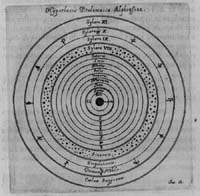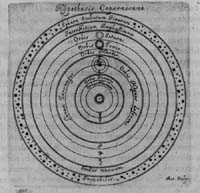Ptolemy and Copernicus on their cosmological postulates
 Representation of Ptolemy's Cosmos taken from Johannes Hevelius'
Selenographia.
Representation of Ptolemy's Cosmos taken from Johannes Hevelius'
Selenographia.
Image by kind permission of the Master and Fellows of Trinity College Cambridge.
While Copernicus is often described as a revolutionary figure in the history of astronomy, in many ways he is rightly regarded as the last representative of the Ptolemaic tradition. His work, De revolutionibus, closely follows the structure of Ptolemy's Almagest.
In the first book of the Almagest, Ptolemy presented the cosmological assumptions, which served as the foundation of his astronomy. Similarly, Copernicus considered cosmological questions in the first book of De revolutionibus. It is worth comparing briefly these sections of the two works.
Ptolemy stated (Book I, chap. 2) that 'the first order of business is to grasp the relationship of the earth taken as a whole to the heavens taken as a whole'. He outlined the 'general preliminary discussion', covering these topics:
- the heaven is spherical in shape and moves spherically;
- the Earth is also, when taken as a whole, sensibly spherical in shape;
- the Earth is in the middle of the heavens, with regard to the senses;
- the Earth has the ratio of a point relative to the size of the heavens;
- the Earth has no motion from place to place.
He added that, as well as the above hypotheses, 'it is proper, as a further preliminary, to introduce the following general notion, that there are two different primary motions in the heavens': the first is the daily motion, which 'carries everything from east to west'; the second is the motion of the sun, moon, and five planets (roughly) along the ecliptic from west to east.
 Representation of Copernicus' Cosmos taken from Johannes Hevelius'
Selenographia.
Representation of Copernicus' Cosmos taken from Johannes Hevelius'
Selenographia.
Image by kind permission of the Master and Fellows of Trinity College Cambridge.
In his preface to De revolutionibus, Copernicus explained that the principles and assumptions, 'called "hypotheses" by the Greeks', have been a source of some disagreement. He stated that 'I acknowledge that I shall treat many topics differently from my predecessors, and yet I shall do so thanks to them, for it was they who first opened the road to the investigation of these very questions'. Copernicus then went on to briefly discuss the following cosmological topics. Like Ptolemy, he only presented a brief discussion of each point.
- The universe is spherical;
- The earth is also spherical;
- The earth forms a single sphere with water;
- The motion of the heavenly bodies is uniform, eternal, and circular or compounded of circular motions;
- Does the earth have a circular motion? What is its position?;
- The immensity of the heavens compared to the size of the earth;
- Why the ancients thought the earth was at rest at the middle of the universe as its centre;
- The inadequacy of the previous arguments and a refutation;
- Can several motions be attributed to the earth? The centre of the universe.
Copernicus then suggested the following order of the heavenly spheres: the highest is the heaven of the fixed stars; the highest planets is Saturn, below which is Jupiter, followed by Mars, Venus, Mercury, the earth (together with its attendant moon), with the sun in the centre of the universe. He admitted that 'all these statements are difficult and almost inconceivable, being of course opposed to the beliefs of many people'. But he hoped that 'as we proceed, with God's help I shall make them clearer than sunlight, at any rate to those who are not unacquainted with the science of astronomy'.
Copernicus went on to elaborate his cosmological views:
At rest in the middle of everything is the sun. For in this most beautiful temple, who would place this lamp in another or better position than that from which it can light up the whole thing at the same time? For, the sun is not inappropriately called by some people the lantern of the universe, its mind by others, and its ruler by still others. [Hermes] the Thrice Greatest labels it a visible god, and Sophocles' Electra, the all-seeing. Thus indeed, as though seated on a royal throne, the sun governs the family of planets revolving around it. Moreover, the earth is not deprived of the moon's attendance. On the contrary, as Aristotle says in a work on animals, the moon has the closest kinship with the earth. Meanwhile the earth has intercourse with the sun, and is impregnated for its yearly parturition. In this arrangement, therefore, we discover a marvelous symmetry of the universe, and an established harmonious linkage between the motion of the spheres and their size, such as can be found in no other way.Many historians of science have argued, convincingly, that the choice between the Ptolemaic and the Copernican systems rested on aesthetic criteria, principles of harmony, symmetry and simplicity.